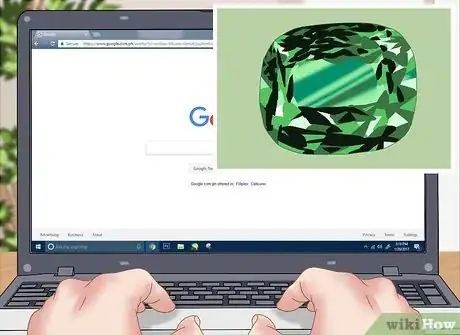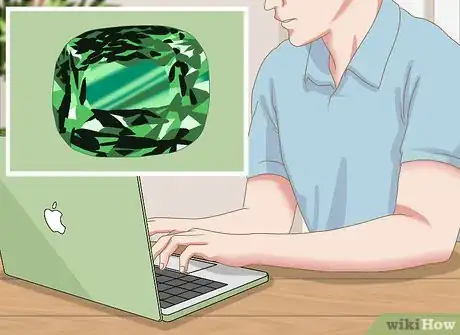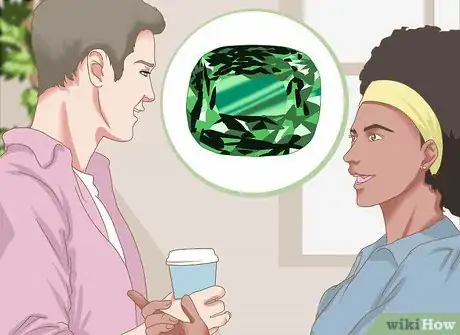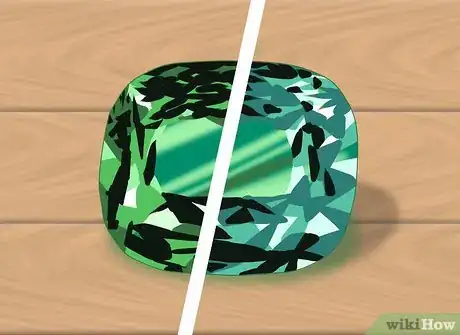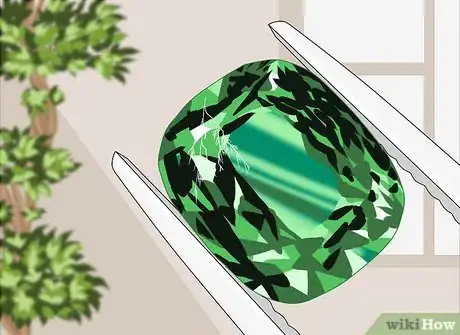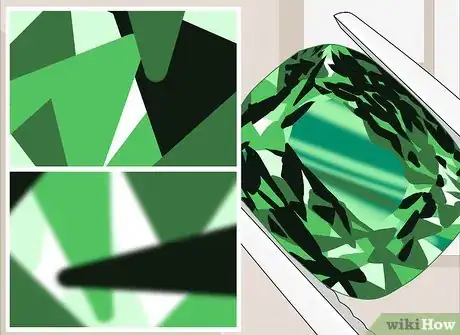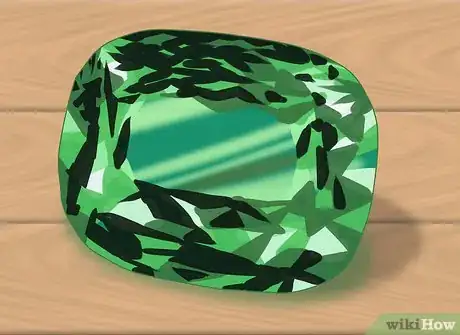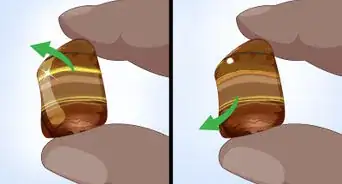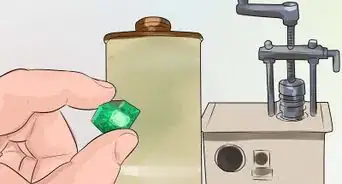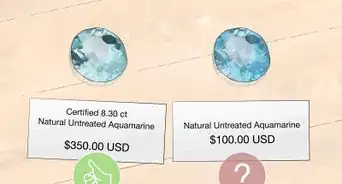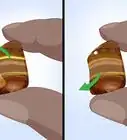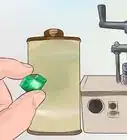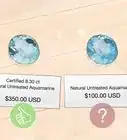This article was co-authored by Kennon Young. Kennon Young is a Master Gemologist Appraiser and the Owner of Vermont Gemological Laboratory in Burlington, Vermont. With over 20 years of experience in the industry, Kennon and his team specialize in handmade engagement rings, wedding bands, and custom jewelry. He attended the Revere Academy of Jewelry Arts, the Gemological Institute of America, and the Rhode Island School of Design Extension. He is a Jewelers of America (JA) Certified Bench Jeweler Technician and received the highest credential in the jewelry appraisal industry, the ASA Master Gemologist Appraiser, in 2016.
There are 22 references cited in this article, which can be found at the bottom of the page.
wikiHow marks an article as reader-approved once it receives enough positive feedback. In this case, 96% of readers who voted found the article helpful, earning it our reader-approved status.
This article has been viewed 215,317 times.
The highest quality emeralds are both natural and rare. They have brilliant sparkle and highly saturated color.[1] Since top-notch emeralds are a significant investment, it is vital to know how to choose them before you decide to purchase anything. Select quality emeralds by ensuring they are natural, investigating the seller and possible treatments of the emerald, and checking the gemstone’s characteristics (like color, clarity and transparency).[2]
Steps
Ensuring the Emerald is Natural
-
1Look for keywords that indicate origin. “Created,” “lab created,” “laboratory grown” or “simulated” are keywords that indicate the emerald is synthetic, not natural. “Chatham” emeralds are also man-made. Be wary of the way a seller uses the word “genuine.” Created emeralds are indeed genuine synthetic emeralds, not genuine natural emeralds.[3]
- Jewelers may tout created emeralds as physically, visually and chemically the same as natural emeralds. However, they are nowhere near as valuable as natural emeralds.
- Other terms used for synthetic emeralds are Gilson, Inamori, and Seiko.[4]
- ”Imitation” emeralds are not the same as lab-created or natural emeralds. They are various materials such as green glass or green cubic zirconia.[5]
- ”Composite” gemstone such as doublets or triplets are stones fused to other materials, such as an emerald top glued to a green glass bottom.[6]
EXPERT TIPKennon Young is a Master Gemologist Appraiser and the Owner of Vermont Gemological Laboratory in Burlington, Vermont. With over 20 years of experience in the industry, Kennon and his team specialize in handmade engagement rings, wedding bands, and custom jewelry. He attended the Revere Academy of Jewelry Arts, the Gemological Institute of America, and the Rhode Island School of Design Extension. He is a Jewelers of America (JA) Certified Bench Jeweler Technician and received the highest credential in the jewelry appraisal industry, the ASA Master Gemologist Appraiser, in 2016.Master Gemologist Appraiser
 Kennon Young
Kennon Young
Master Gemologist AppraiserConsider the country of origin when choosing an emerald. Small emeralds from Colombia with less than perfect color are considered more valuable than larger emeralds with better clarity from Mozambique. You should also consider the historical provenance — whether it was used in a movie or owned by a celebrity or politician.
-
2Evaluate the trustworthiness of the seller. Determining the value of colored gemstones takes years of experience. While you can do your own research, it’s best to utilize the guidance of a professional when considering such a large investment.[7] Find a jeweler who has gemological credentials, is informed about emeralds, and has multiple natural emeralds with different styles that you can view simultaneously.[8]
- Research the place from which you are buying your emerald. There are many synthetic and imitation emeralds on the market, and it is imperative to be certain you are purchasing yours from a reputable dealer. Look for online reviews of the seller that come from a website other than the seller itself.
- Gemological credentials come from an educational organization like the Gemological Institute of America (GIA) or the American Gem Society (AGS). The jeweler will have initials after their name, such as RJ (Registered Jeweler) or CG (Certified Gemologist). You can look up the initials in a search engine to find out exactly how much education the seller has achieved in their field.[9]
Advertisement -
3Find out if and how the emerald has been treated. Because they are prone to fractures, most emeralds are treated somehow.[10] However, if the stone was significantly treated to improve its appearance and hide flaws, the emerald may appear higher quality than it actually is. If the stone was treated, find out whether the treatment is major or insignificant.[11] Ask if the stone has been examined for fillers.[12] Get a report from an independent laboratory that can confirm the emerald is natural and to what extent it’s been treated.[13]
- Don’t rely on a lab report that comes with the stone and is labeled as “independent.” Find your own, unbiased third party, such as a certified gemologist or appraisal organization.
- Stones may be sold without the seller disclosing the fact it was clarity enhanced, which is considered a deceptive practice.[14]
- Some polymer type resins will disintegrate and yellow with age. Avoid emeralds with certain oil treatments, as oils like cedar will cause yellow staining inside the stone after repeated oiling. Also remember all oil treatments will dry out and require re-oiling.
Evaluating the Emerald
-
1Study the color. Color is one of the top indications of quality in an emerald.[15] The rarer and finer the clarity and color are the more value the gemstone will hold. Generally the lighter the crystal is, the more clarity, carat and cut matter. High quality emeralds have intense saturation and a vibrant crystal.[16]
- The color should be distributed evenly, without zones of different color visible to the naked eye.[17]
- In general, the purer the green hue, the better the color is considered to be. All natural gemstones will have some undertone of other hues, but the blueness or yellowness in the emerald should be slight as well as beautiful.[18]
- The emerald should be bright in its hue, like a spring green. If the appearance is more of a dark green “sleepy” hue, it isn’t an investment grade emerald.[19]
-
2Look for inclusions and fractures. Emeralds with many flaws and cracks around the corners aren’t good candidates for setting in jewelry. Even if they can be set without damage, they aren’t likely to last long in the setting. Check the emerald with a loupe using reflected light to check for cracks and inclusions. Cracks look like little hairs or threads on the plane of a facet.[20]
- Natural emeralds usually have inclusions, and they are typically visible to the unaided eye.[21] If the gem is priced well and appears flawless under a loupe or microscope, it is probably fake.[22]
- Most emeralds have some cracks or fissures, but they shouldn't be rampant, or encircle the stone deeply(this can cause the stone to break in two).
-
3Examine the cut and brilliance. An emerald cut with skill will have facets that are positioned perfectly. As you move the stone, light should ripple sharply over them. The whole surface should be richly green without specific areas lighter or darker.[23] A high quality emerald is alluring and has a lively sparkle.[24]
- There are many cuts of emeralds. The most popular is the “emerald cut,” which is square or rectangular with a step cut.[25] Emeralds are considered type 3 gemstones, and this cut was designed to prevent breakage by placing facets in the four corners.
- Lower quality cuts with less faceting allow light to come through the back of the stone enough that you could read text through the crown of the gem (called “windowing”). On the other hand, gems with pavilions too deep have dark areas you can see face-up, which is a loss of light (called “extinction”).
-
4Check for transparency. A high quality emerald may be a bit cloudy, but should possess a significant amount of transparency. Opaque and semi-opaque emeralds are a lot more common and aren’t worth as much.[26]
-
5Find out the carat weight. The price of a quality emerald will rise with its carat weight.[27] When two to three carats or more, emeralds outweigh diamonds in cost by far.[28] There are various gemstone weight charts and calculators available online that you can use to find out more about measuring emeralds.
References
- ↑ https://books.google.com/books?id=4UANp6MCTSQC&lpg=PA22&pg=PA22#v=onepage&q&f=false
- ↑ https://books.google.com/books?id=WUBWz22wRtEC&lpg=PA147&pg=PA147#v=onepage&q&f=false
- ↑ https://www.gemsociety.org/article/is-a-lab-created-emerald-a-real-emerald/
- ↑ http://www.yourgemologist.com/syntheticemerald.html
- ↑ http://geology.com/gemstones/emerald/
- ↑ https://books.google.com/books?id=4UANp6MCTSQC&lpg=PA25&pg=PA74#v=onepage&q&f=false
- ↑ https://books.google.com/books?id=4UANp6MCTSQC&lpg=PA25&pg=PA25#v=onepage&q&f=false
- ↑ http://4csblog.gia.edu/wp-content/uploads/2014/02/Emerald-Buying-Guide.pdf
- ↑ https://www.americangemsociety.org/en/titlesconfirmingmemb
- ↑ https://www.gemsociety.org/article/just-ask-jeff-are-all-emeralds-treated-and-what-is-your-opinion/
- ↑ http://www.gia.edu/gem-treatment
- ↑ https://books.google.com/books?id=4UANp6MCTSQC&lpg=PA25&pg=PA102#v=onepage&q&f=false
- ↑ http://4csblog.gia.edu/wp-content/uploads/2014/02/Emerald-Buying-Guide.pdf
- ↑ https://www.ftc.gov/system/files/documents/federal_register_notices/2015/12/jewelryguidesfrn.pdf
- ↑ http://4csblog.gia.edu/wp-content/uploads/2014/02/Emerald-Buying-Guide.pdf
- ↑ https://books.google.com/books?id=4UANp6MCTSQC&lpg=PA24&pg=PA24#v=onepage&q&f=false
- ↑ https://www.gia.edu/emerald-quality-factor
- ↑ https://books.google.com/books?id=4UANp6MCTSQC&lpg=PA25&pg=PA25#v=onepage&q&f=false
- ↑ http://www.ebay.com/gds/Investment-Emerald-Gemstones-/10000000000958266/g.html
- ↑ https://books.google.com/books?id=qDuSyVsv4VEC&lpg=PA60&ots=xqDcZUgsvw&pg=PA60#v=onepage&q&f=false
- ↑ http://www.gia.edu/emerald#buyers-guide
- ↑ http://4csblog.gia.edu/wp-content/uploads/2014/02/Emerald-Buying-Guide.pdf
- ↑ https://www4.gia.edu/tryelearning/220-08/media/resources/cs08_printable.pdf
- ↑ https://books.google.com/books?id=4UANp6MCTSQC&lpg=PA22&pg=PA22#v=onepage&q&f=false
- ↑ http://4csblog.gia.edu/wp-content/uploads/2014/02/Emerald-Buying-Guide.pdf
- ↑ http://www.minerals.net/mineral/emerald.aspx
- ↑ http://www.gia.edu/emerald#buyers-guide
- ↑ https://www4.gia.edu/tryelearning/220-08/media/resources/cs08_printable.pdf
- ↑ https://books.google.com/books?id=4UANp6MCTSQC&lpg=PA24&pg=PA24#v=onepage&q&f=false
